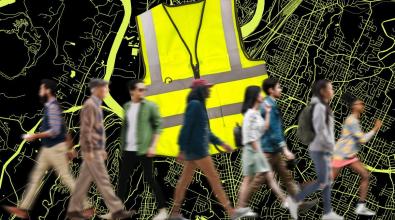 Read More
Read More
3 AI roadblocks—and how to overcome them

Listen to This Article
Evidence of uneven AI adoption in the private sector grows by the day, with executives worried about falling behind more tech-savvy competitors. But the stakes are different, and considerably higher, in government. For local leaders, AI isn’t about winning a race. It’s about unlocking new problem-solving capacity to deliver better services and meet pressing resident needs.
Even so, city governments face real barriers to further adoption, including persistent concerns about accuracy and privacy, procurement hurdles, and too little space for civil-servant experimentation. The good news? Innovative leaders are already showing how to overcome these obstacles. And, in doing so, they’re reaping insights of use to others aiming to do the same.
Designing AI tools tailored to employees’ needs.
Boston Chief Innovation Officer Santiago Garces has no doubt that his city-hall colleagues want to push their efforts forward with AI, and he’s got the data to prove it. His team recently conducted a survey of 600 Boston city employees and found that 78 percent of them want to further integrate the technology into their work. When asked what’s holding them back, security, accuracy, and intellectual property are among civil servants’ top concerns.
Boston’s solution: Developing AI tools with more specific use cases, such as speeding up the procurement process, and employee concerns in mind from the start.
Following through on a project they began last year, Garces and his team recently deployed a tool called Bitbot that can answer employees’ questions about procurement. Because it was trained on dozens of procurement documents, as well as state law, local ordinances, and city best practices, Garces argues the tool is best described not as a chatbot (though it resembles one) and more like the AI version of a handbook people know they can trust. And while the city’s randomized controlled trial of the tool’s impact is still wrapping up, Garces says the city has generally seen faster task completion and higher levels of accuracy from employees using it. At the same time, the tool is set up not to send information back to the major tech companies the way most public-facing AI tools do, which helps address employee concerns around privacy and security.
While not every city has the resources to develop products like this on its own, Garces notes that working with university partners (he works closely with Northeastern University) can be very affordable. And this sort of approach could help civil servants everywhere be more comfortable in pushing AI use forward.
“They want the city-provided tool that they know that they can trust,” Garces explains.
Rapidly prototyping to de-risk big purchases.
When not developing bespoke AI solutions, cities turn to outside vendors. And they’re increasingly doing so with great success and impact, according to Mitchell Weiss, a Harvard Business School professor and senior advisor to the Bloomberg Harvard City Leadership Initiative. Still, adoption is uneven. “Some local leaders are wary [of making a sizeable outlay], given broader concerns in the private sector and worries about the return on investment, " he adds. Tight city budgets make the stakes of a misstep especially high, and private-sector caution only reinforces city leaders’ hesitation.
That’s why some cities are shaking up how they buy AI tools, both to speed that procurement process up and make sure that they stay laser-focused on boosting efficiency and effectiveness, rather than pursuing new tech for its own sake. Call it “try before you buy” for cities and AI.
Take San Antonio. Emily Royall, who until this past month worked as a senior manager for the emerging technology division in the city, helped run a rapid prototyping initiative that ensures potential AI contracts address tangible, department-level needs. The city spends up to $25,000 on three-to-six-month pilots before committing to longer-term vendor deals. The goal is to gauge impact and kick the tires first.
Longer term, Royall and her new colleagues at the Procurement Excellence Network (she joined the team in September) believe one way cities will take their AI games to the next level is by banding together and conducting joint solicitations. And unlike traditional approaches to cooperative purchasing, cities are now determined to take a more muscular role in deciding for themselves what the most valuable AI use cases look like, and then calling on industry to develop the products that bring them to life while still meeting cities’ privacy concerns.
“This is about pooling purchasing power to deliver the outcomes that governments actually want to see from their implementation of the technology,” she says.
Leading teams toward bolder experimentation.
One of the cities leading that charge when it comes to local governments shaping the AI market is San Jose, Calif., which recently announced the first winners of its AI Incentive Program, offering grants to AI startups taking on everything from food waste to maternal health. But that’s not the only way the city is standing out. San Jose is also a model when it comes to creating a workplace where employees trust that leaders will have their backs as they constantly experiment in new ways with the technology.
“Integrating AI into city hall isn’t just a question of expense,” explains Mai-Ling Garcia, director of emerging technologies and AI at the Bloomberg Centers for Government Excellence and Public Innovation at Johns Hopkins University. “It also requires that you have the political capital to spend to take risks.”
And San Jose Mayor Matt Mahan is spending that political capital to great effect.
“He tells us it's OK if you try something and it doesn't work—you will not be penalized so long as there's sufficient due diligence,” explains Stephen Caines, the city’s chief innovation officer.
But it’s not just what the mayor tells civil servants. And it’s not just the training San Jose provides through its data and AI upskilling programs, which are delivered in partnership with San Jose State University and which the mayor wants to train 1,000 more civil servants next year. It’s the larger political climate he’s cultivated to encourage AI experimentation.
For example, the mayor presented a memo to the city council two years ago calling for the city to seize the moment and help shape (and stimulate) the emerging industry, and to integrate it across city operations. When local lawmakers voted for it, it helped clarify for everyone in city hall that pushing public-sector AI use forward wasn’t just allowed, but a key part of their job.
“I am often reminding policymakers and my colleagues that we spend probably a disproportionate amount of time focused on the technology itself or the latest hot startup versus what moves the needle the most, which is the people who will use these tools,” Mayor Mahan tells Bloomberg Cities. He adds that it isn’t just him, but city leaders across the organization who encourage experimentation with the technology.
“How you choose to react to failure matters a tremendous amount for building culture,” Mayor Mahan, who is participating in the Bloomberg Harvard City Leadership Initiative, explains.
Among San Jose’s most concrete AI successes so far is a traffic-signal initiative that has already shown the potential to reduce resident commute times by 20 percent. And if the mayor and his team have anything to say about it, that’s just the start of not just pushing AI use forward in their city but encouraging other cities to experiment, too.
“The outdated vision of government is that we are merely consumers of technology,” Caines, the local innovation officer, explains. “The thesis that we're putting forward is that government can be not only a lab where technology can be deployed, it can also be a valuable partner in co-creation, and we can actually serve as a market indicator by highlighting use cases that make a difference for residents.”

